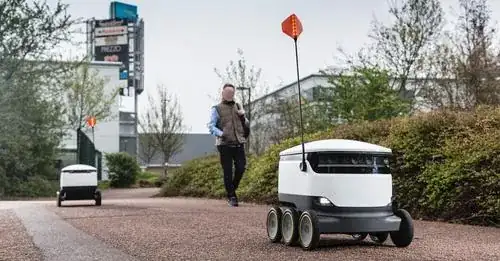tl;dr: The claim is nearly true. Based on publicly available data, the robot uses the energy required to heat water for one cup of tea every 27 minutes. This is probably a bit less than the time needed for an "average delivery", but it's feasible.
Starship robot metrics
Back in 2018, Starship partnered with Swiss Post to conduct pilot testing of the Starship robot in Dübendorf. During this test, Swiss Post published a fact sheet about the robot including the following metrics:
- Vehicle weight: 23 kg
- Max payload: 10 kg
- Average service speed: 3 km/h
- Battery: 8,000 mAh, 18.5 V
- Range: 6 km / 2 hours
- Charging time: 45 min (0.75 hours)
- Charge power consumption: up to 250 W
Hourly energy consumption
Based on the battery capacity and voltage we can calculate that the energy consumption is 148 Wh over it's entire 2 hour range:
8 Ah * 18.5 V = 148 Wh
But this ignores charging efficiency. Per the latest US and EU charger efficiency requirements, an 18.5 V charger up to 250 W must have an efficiency of at least 88%, giving a total consumption of about 168 Wh:
148 Wh / 0.88 = 168.18 Wh
How many cups of tea is that?
Thanks to Schwern's answer, we know that it takes 37.5 Wh to boil water for one cup of tea.
If that's the unit of measure for an "average delivery", that means the robot should be able to complete about 4.5 deliveries on a single battery charge:
168.18 Wh / 37.5 Wh = 4.48 deliveries
Since a charge lasts for two hours, that gives an approximate time of 27 minutes per delivery, covering 1.3 km:
120 minutes / 4.48 deliveries = 26.76 min/delivery
6 km / 4.48 deliveries = 1.34 km/delivery
Is 27 minutes reasonable for an "average delivery" by a Starship robot?
The press release doesn't define "average delivery" -- it just says that packages are delivered "in minutes". But there are some clues elsewhere:
So, let's say the range is 20 to 45 minutes. But that includes the transaction and packing time, during which the robot isn't using any energy -- so the actual driving time is probably closer to 10 to 35 minutes.
And that doesn't include the return trip -- so in order to complete a delivery, the robot needs 20 to 70 minutes.
Conclusion: The claim is almost true
For the claim to be true, the robot would have to complete an "average delivery" in 27 minutes. Based on published wait times for delivery, this is close to the low end of travel time. Unless most trips are very short (bringing the average down), it's likely that each trip is using a bit more than the energy to heat water for one cup of tea.
At the high end, the robot uses enough to make almost three cups of tea:
(70 min / 120 min) * 168.18 Wh = 98.11 Wh
98.11 Wh / 37.5 Wh = 2.62 cups of tea
For anyone curious, I found my way to this answer by way of a research paper on efficiency of delivery robots: Vepsäläinen, Jari. 2022. Energy Demand Analysis and Powertrain Design of a High-Speed Delivery Robot Using Synthetic Driving Cycles. Energies 15, no. 6: 2198. Their calculation uses a lower value for power consumption (63.3 Wh/h) because they ignore anything that isn't directly related to locomotion: lights, sounds, charging efficiency, electronics, etc.
